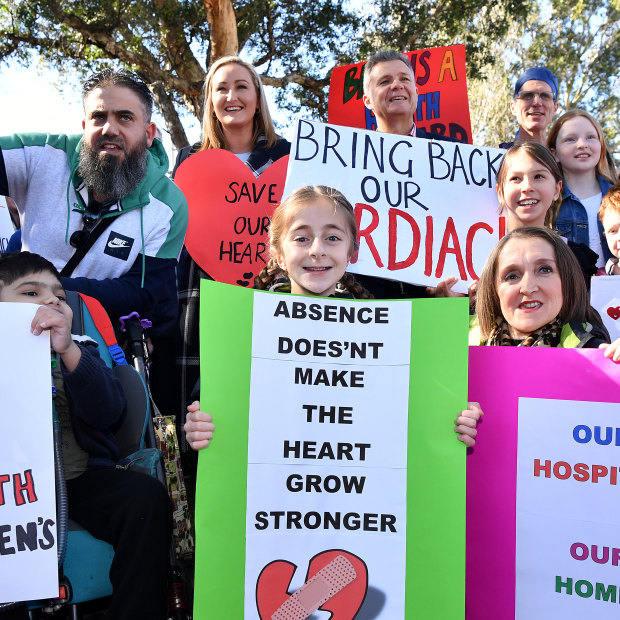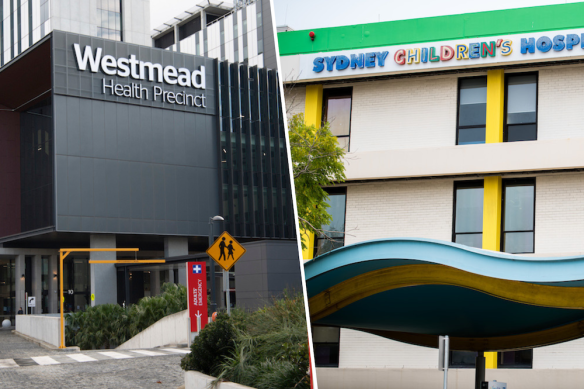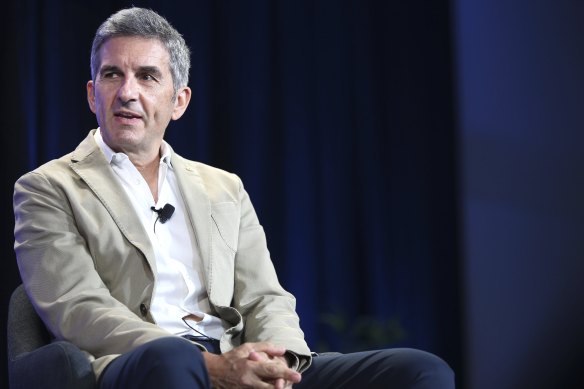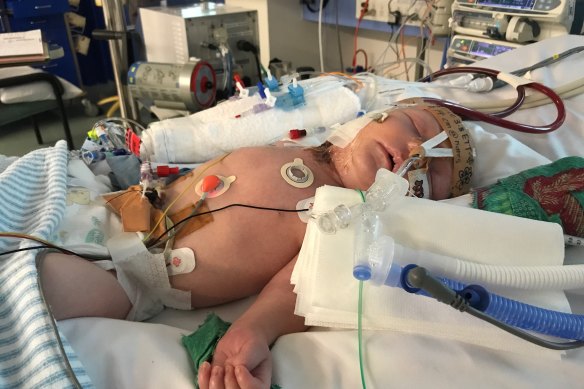Home » World News »
‘We aren’t doing the right thing by the children’: What’s behind a bitter Sydney hospital feud?
By Anne Hyland and Angus Thomson
The long-running dispute over the provision of cardiac surgery in Sydney has never died down.Credit: AAP
Save articles for later
Add articles to your saved list and come back to them any time.
In March 2020, Elizabeth Crouch, a stern-looking woman in her mid-50s, became chair of the Sydney Children’s Hospitals Network. The pandemic had only just started as she took on one of the toughest jobs in the state, governing the network responsible for the two biggest children’s hospitals in NSW: the Sydney Children’s Hospital at Randwick, in the city’s east, and the Children’s Hospital at Westmead, in the west.
Crouch added the part-time chair’s job at the Sydney Children’s Hospitals Network to the 11 other roles that she held, which included public company directorships, directorships of private groups and also state government organisations. While Crouch was chair of a “network”, she was also well-networked, but the sheer number of her roles raised the question: did she have the time and resources to devote to all of them, especially the hospitals’ group?
“It’s a super complex entity, and it needs time,” explains businessman and philanthropist Daniel Petre, who’s also a former Sydney Children’s Hospitals Network director. “You can’t be doing that well if you have got a tonne of other things on.
“And by well, I mean you need to be solving the very complex and critical issues around planning for and delivering the range of paediatric service requirements, not only for the children of Sydney, but also for the Children of NSW and where these services should sit.”
The Sydney Children’s Hospitals Network has more than 8000 employees. Its size means that if it were a public company, it would rank among the 200 biggest corporations on the Australian sharemarket.
“To have two public company director roles and a chairmanship of an employer of an 8000 people, that would be considered a full book before you add anything else,” says Dean Paatsch, a corporate governance expert, who runs consulting firm Ownership Matters.
“If you have a crisis in one organisation, where you play a crucial role, then that is your full-time role. Your duty is to all the stakeholders. If you have a crisis in more than one of your entities at the same time, it’s completely unmanageable, and that’s the problem with workload.”
Crouch, who declined to be interviewed, relinquished none of her positions as the pandemic stretched both children’s hospitals beyond their limits, with bed, staff and medical equipment shortages. While COVID-19 was the biggest issue confronting Crouch and the hospitals’ management team, when she started, it was by no means the only problem.
The year before Crouch joined the network, the organisation had been racked by instability. The chief executive and chair had stepped down, and its director of paediatric cardiac services had resigned, following a bitter public fight with hundreds of senior medical staff at the Randwick hospital. Senior doctors had passed a no-confidence motion in management and the board, and voted to quit the network.
The Children’s Hospital at Westmead and Sydney Children’s Hospital in Randwick have been a loggerheads for 11 years over the provision of paediatric cardiothoracic surgical services.
As well, a review led by Dr Kathy Alexander, released in June 2019, had examined the Sydney Children’s Hospitals Networks governance. It found that NSW Health and successive state governments had provided “insufficient” resources to create an organisation of such “complexity”, and that planning, implementing and evaluation of the strategy to create it, was also “insufficient”.
The review found that the board, whose responsibility is to oversee and review management’s performance and strategy, had “apparently not monitored effectively” what was happening in the set-up of Australia’s largest paediatric health care governing body.
Sydney Children’s Hospitals Network has a $1 billion budget and comprises not only NSW’s two biggest paediatric hospitals, but also other services such as Bear Cottage, the Newborn and Paediatric Emergency Transport Service, Kids Research and the Children’s Court Clinic.
The report delivered by Alexander and her panel would remind board and management, as well as NSW Health and politicians, that their job was to support the treatment and care of children across the state. This meant also supporting the NSW paediatric workforce with a structure that enabled them to be agile and capable in providing care.
A similar argument was made in a 2008 report by then special counsel, Peter Garling, who led the Special Commission of Inquiry into Acute Care Services in NSW Public Hospitals.
Garling, who later became a Supreme Court judge, warned against a breakdown of relations between clinicians and management across the state’s public hospitals, stating it would alienate “the most skilled in the medical workforce from service in the public system”.
“If it continues, NSW will risk losing one of the crown jewels of its public hospital system: the engagement of the best and brightest from the professions who are able to provide world-class care in public hospitals free of charge to the patient,” he said.
The Garling review suggested the establishment of one major children’s hospital in Sydney, which was neither at Westmead nor Randwick. The recommendation wasn’t taken up by the then Labor state government.
Instead, in 2010, after a succession of Labor premiers, the short-lived Keneally government established the Sydney Children’s Hospitals Network to oversee both institutions.
There were problems from the outset.
The Children’s Hospital Westmead and the Sydney Children’s Hospital at Randwick have very different cultures, and also different approaches to care delivery models. When the network was formed not enough attention was given to how different those approaches were.
An example of those differences is that Westmead has always worked on the principle that paediatric services should stand alone from adult services, whereas Randwick has integrated with adult services. It meant that the Children’s Hospital Westmead tried to have its own pathology, medical imaging, and operating theatre facilities, whereas Randwick tried to have paediatric services embedded with adult services in such areas.
Neither approach was right or wrong.
As well, each campus saw itself as acting in the best interests of children and their families, and found it difficult to acknowledge that high-quality care was delivered at both campuses, not just their own. It meant that rivalry flourished.
On top of this, the Children’s Hospital Westmead has always been twice the size of Randwick and is situated where the population of Sydney is growing. Like many larger entities in a merger, some say Westmead saw things more as a takeover than a merger of equals when the network was established.
These are some of the reasons why there has been significant challenges since the network’s formation.
The most public of the problems at the network has been the fight over the delivery of paediatric cardiothoracic surgical services between the two hospitals. Incredibly, it has dragged on for 11 years without resolution.
During that time hundreds of thousands of dollars in taxpayers’ money has been spent by NSW Health conducting multiple reviews, including the Henry and Marshall reviews, as well as panels and committees, to investigate issues at the network, particularly the delivery of paediatric cardiothoracic surgical services.
The conflict over the delivery of cardiac services has flared again, though it never went away. It was raised in parliamentary hearings recently, in the media, and in a petition. There’s also the prospect of a protest being launched by Randwick doctors and senior medical staff next month.
None of this was discussed at the network’s annual meeting on Thursday, which lasted less than one hour.
Ambulances arriving at the emergency section of Westmead Children’s Hospital.Credit: Edwina Pickles
Neither Elizabeth Crouch, whose workload has been cut back to ten roles, nor chief executive Cathryn Cox, spoke about how they were addressing one of the biggest problems on their agenda: How to end the conflict that exists within the paediatric cardiothoracic surgical program at the two hospitals.
Cox declined a request for an interview.
In Garling’s report, conflict between management and top medical staff was identified as a risk. One of the commonsense conclusions he reached, and warned about, was that if it wasn’t resolved the “best and the brightest from the professions” would quit. His counsel: fix the divide.
The divide remained inside the two hospitals’ paediatric cardiothoracic surgical program, and with management. As a result, some of the “best and the brightest” resigned.
David Winlaw and Yishay Orr, who were among NSW’s top paediatric cardiothoracic surgeons, both quit in the past three years to take up roles in the US. Orr conducted multiple heart transplants during the pandemic when previously such cases went to Melbourne.
Orr resigned this past April. In May, the Minns government announced it was establishing a dedicated heart transplant unit at Westmead, even though NSW was short-staffed of paediatric cardiothoracic surgeons.
Such surgeons are hard to recruit but the network’s director of cardiac services, Dr Phil Roberts, is confident of securing replacements. He says Westmead’s new heart transplant unit would help attract talent.
“I’ve just come back from the World Congress of Paediatric Cardiology and Cardiac Surgery, which was in Washington DC in September, and during that time I managed to talk to several well-known international cardiac surgeons to replace the people that we lost.”
“The current situation of only having two surgeons doing the majority of work, with one covering Randwick, will improve to where we’ll have one in four on-call, plus an additional surgeon at Randwick.”
The conflict over changes to the delivery of paediatric cardiothoracic surgical services, has been portrayed in the media, and by politicians, as a turf war between the hospitals’ power hungry doctors.
And yet, the decision-making around this issue rests within the network and NSW Health.
Daniel Petre, who supports the centralisation of complex paediatric cardiothoracic surgical services at Westmead, says responsibility for the unresolved issue should be borne by the network’s board and management.
Businessman, philanthropist and former SCHN director Daniel Petre. “We aren’t doing the right thing by the children of NSW.”Credit: James Alcock
“We aren’t doing the right thing by the children of NSW, by the state or by the scarce resources available in funding by not solving this problem,” he says.
“It seems every board, since the advice was given, has continued to kick it down the road, and are not trying to solve it with the government of the day. And solving it does not mean making both sides happy but doing what is right.” Petre is a former executive for Bill Gates at Microsoft and later for Kerry Packer.
As far back as 2012, a decision was made that more complex paediatric cardiothoracic surgery would be centralised at Westmead, and that cardiac services could be delivered by one team across two hospitals.
Since then, further decisions were made, including recently by newly installed Health Minister Ryan Park, to provide only low-complexity cardiac surgery at Randwick children’s hospital.
When he was in opposition, Park supported the delivery of medium complexity services at Randwick.
In July, Park wrote to Randwick’s doctors informing them medium and high complexity cardiac surgeries – including cardiac bypass – would only be performed at Westmead.
Randwick doctors in August replied that this would have a knock-on effect across other specialities, including oncology, trauma, ENT and thoracic surgery.
“We agree that there is a role for the highest complexity, low-volume paediatric cardiac surgeries to be centralised at the Children’s Hospital Westmead, but not all the paediatric cardiac surgeries,” says Puneet Singh, Randwick’s medical staff council chair, who’s also a children’s intensive care unit staff specialist.
A baby hooked up to an ECMO machine at Sydney Children\’s Hospital.
“For so many decades, we have safely provided low-to-medium complexity cardiac surgery here. Our results are good. The repercussions of not being able to provide cardiac bypass surgery are huge for the children who arrive at Sydney Children’s Hospital Randwick, and it will have a profound effect on our services.”
John Awad, a paediatric cardiac anaesthetist at Randwick, recently said that “75 per cent of the state’s critically ill children” that need to be sent to a paediatric ICU, arrive at that campus. He said this at a Randwick Council meeting, as he sought support for the hospital staff’s concerns about only being allowed by the state government to provide low-complexity cardiac services.
In 2021, a NSW Paediatric Cardiac Services Model of Care was prepared for the network. It stated how cardiac bypass, which involves the use of a heart-lung machine during an operation, was necessary in other procedures, for example, in complex airway surgery, which also required the entire cardiac surgery team working closely with an Ear, Nose and Throat team.
Heart-lung machines are used for cardiac bypass in daily operations.
A similar machine known as extracorporeal membrane oxygenation, or ECMO, is also used on very sick children to keep them alive by doctors if they arrive critically ill. For example, they may have sepsis, or cancer and have developed life-threatening pneumonia. ECMO, also a heart-lung machine, can be used on critically ill children for weeks.
Randwick doctors argue a cardiac surgeon is needed to connect a child to an ECMO machine. NSW Health Minister Ryan Park disagrees. At a NSW budget estimate’s committee last month, Park said he was “confident we can do it” without cardiac surgeons.
Greens MP Dr Amanda Cohn told Park no hospital in Australia or New Zealand provided ECMO without a cardiac surgical program.
The Australian and New Zealand Association of Paediatric Surgeons president Dr Peter Borzi also says ECMO requires a cardiac surgeon’s skills.
Phil Roberts disagrees. “You do not need a cardiac surgeon to deliver ECMO. There are hospitals in Paris for neonatal babies that deliver ECMO; they don’t have a cardiac surgeon on site.”
“When you need to do ECMO by opening a chest then you do need a cardiac surgeon, but that would be the exception.”
Roberts argues the decision to ensure cardiac bypass occurs at only one site formalises arrangements that have “been the case for the last five years without any adverse consequences for any children in the state of NSW”.
He says the duplication of services and resources has to stop. “It just does not work because you don’t create enough expertise within a group of people.”
In time, he expects the conflict will cease, even though it’s been 11 years. “The experience around the world is that this will eventually come to an end. This is a way that the world is going … and we’re really just mirroring that.”
Start the day with a summary of the day’s most important and interesting stories, analysis and insights. Sign up for our Morning Edition newsletter.
Most Viewed in National
Source: Read Full Article







